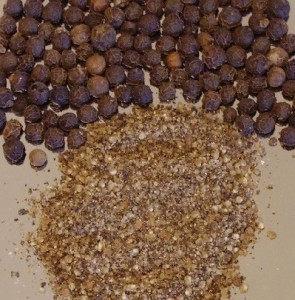Spices are something people, food service and even manufacturers may pooh-pooh when considering the risks of microbial contamination. Black pepper, white  pepper, red pepper, rainbow pepper, curry, anise, fennel, turmeric, broccoli powder and mixtures. Don’t get me started on herbs. Van Doren et al. review spice related outbreaks in Food Microbiology; abstract below:
pepper, red pepper, rainbow pepper, curry, anise, fennel, turmeric, broccoli powder and mixtures. Don’t get me started on herbs. Van Doren et al. review spice related outbreaks in Food Microbiology; abstract below:
This review identified fourteen reported illness outbreaks attributed to consumption of pathogen-contaminated spice during the period 1973-2010. Countries reporting outbreaks included Canada, Denmark, England and Wales, France, Germany, New Zealand, Norway, Serbia, and the United States. Together, these outbreaks resulted in 1,946 reported human illnesses, 128 hospitalizations and two deaths. Infants/children were the primary population segments impacted by 36% (5/14) of spice-attributed outbreaks. Four outbreaks were associated with multiple organisms. Salmonella enterica subspecies enterica was identified as the causative agent in 71% (10/14) of outbreaks, accounting for 87% of reported illnesses.Bacillus spp. was identified as the causative agent in 29% (4/10) of outbreaks, accounting for 13% of illnesses. 71% (10/14) of outbreaks were associated with spices classified as fruits or seeds of the source plant. Consumption of ready-to-eat foods prepared with spices applied after the final food manufacturing pathogen reduction step accounted for 70% of illnesses. Pathogen growth in spiced food is suspected to have played a role in some outbreaks, but it was not likely a contributing factor in three of the largerSalmonella outbreaks, which involved low-moisture foods. Root causes of  spice contamination included contributions from both early and late stages of the farm-to-table continuum.
spice contamination included contributions from both early and late stages of the farm-to-table continuum.
Food MicrobiologyJane M. Van Doren, Karen P. Neil, Mickey Parish, Laura
Gieraltowski, L. Gould hannah, Kathy L. Gombas.
